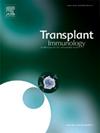CMV management of patients with leukopenia after CMV high-risk kidney transplantation
IF 1.4
4区 医学
Q4 IMMUNOLOGY
引用次数: 0
Abstract
Background
For CMV high-risk constellations, guidelines recommend 3–6 months of prophylaxis with valganciclovir (VGCV). Management in preventing CMV primary infection in patients developing VGCV-associated leukopenia remains challenging.
Methods
We retrospectively analyzed the development of leukopenia during VGCV prophylaxis in 57 seronegative kidney recipients of a CMV-seropositive donor between 2008 and 2021. We analyzed CMV risk and development of CMV-specific T cells in the first post-transplant year depending on leukopenia during VGCV prophylaxis and management with CMV-IVIg.
Results
Leukopenia developed in 19/57 patients, with a significant difference in leukocyte counts occurring after 10 weeks of VGCV prophylaxis compared to patients without leukopenia (p = 0.0003). VGCV discontinuation led to leukocyte reconstitution, which tended to be faster in patients receiving additional prophylaxis with CMV-IVIg after VGCV discontinuation (n = 11, p = 0.083). In the first post-transplant year, patients with leukopenia had no higher risk for severe CMV events. Interestingly, patients receiving CMV-IVIg prophylaxis showed a significantly lower peak CMV-load during primary infection (p = 0.040), with no difference in CMV-specific T-cell levels compared to patients without leukopenia or patients with additional CMV-IVIg prophylaxis (p = 0.972). Patients developing adequate CMV-specific T-cell responses less frequently underwent CMV reactivation 50 days following primary infection.
Conclusion
Leukopenia developed late during VGCV prophylaxis and did not result in an increased risk for CMV primary infections or severe disease. Leukopenic patients receiving CMV-IVIg tended to have a faster leukocyte reconstitution and had lower peak DNAemia, which did not adversely affect CMV-specific T-cell induction. CMV-IVIg may therefore be considered as an alternative prophylactic strategy in patients with VGCV-associated leukopenia.
CMV高危肾移植后白细胞减少患者的CMV管理。
背景:对于巨细胞病毒高危星座,指南建议使用缬更昔洛韦(VGCV)预防3-6个月 。在发生巨细胞病毒相关白细胞减少的患者中预防巨细胞病毒原发感染的管理仍然具有挑战性。方法:我们回顾性分析了2008年至2021年间57名cmv血清阳性供者的血清阴性肾受者在预防VGCV期间白细胞减少的发生情况。我们分析了CMV风险和移植后第一年CMV特异性T细胞的发展,这取决于CMV- ivig预防和管理期间的白细胞减少。结果:57例患者中有19例发生白细胞减少,与未发生白细胞减少的患者相比,预防VGCV 10 周后白细胞计数有显著差异(p = 0.0003)。VGCV停药导致白细胞重建,在停药后接受CMV-IVIg额外预防的患者中,白细胞重建往往更快(n = 11,p = 0.083)。在移植后的第一年,白细胞减少患者发生严重巨细胞病毒事件的风险没有增加。有趣的是,接受CMV-IVIg预防的患者在原发性感染期间的cmv峰值负荷显着降低(p = 0.040),与没有白细胞减少的患者或额外CMV-IVIg预防的患者相比,cmv特异性t细胞水平无差异(p = 0.972)。在初次感染后50 天,出现充分CMV特异性t细胞反应的患者较少发生CMV再激活。结论:白细胞减少在巨细胞病毒预防期间发生较晚,不会导致巨细胞病毒原发性感染或严重疾病的风险增加。接受CMV-IVIg治疗的白细胞减少患者往往有更快的白细胞重建和更低的峰值dna血症,这对cmv特异性t细胞诱导没有不利影响。因此,CMV-IVIg可能被认为是vgcv相关白细胞减少患者的另一种预防策略。
本文章由计算机程序翻译,如有差异,请以英文原文为准。
求助全文
约1分钟内获得全文
求助全文
来源期刊

Transplant immunology
医学-免疫学
CiteScore
2.10
自引率
13.30%
发文量
198
审稿时长
48 days
期刊介绍:
Transplant Immunology will publish up-to-date information on all aspects of the broad field it encompasses. The journal will be directed at (basic) scientists, tissue typers, transplant physicians and surgeons, and research and data on all immunological aspects of organ-, tissue- and (haematopoietic) stem cell transplantation are of potential interest to the readers of Transplant Immunology. Original papers, Review articles and Hypotheses will be considered for publication and submitted manuscripts will be rapidly peer-reviewed and published. They will be judged on the basis of scientific merit, originality, timeliness and quality.
 求助内容:
求助内容: 应助结果提醒方式:
应助结果提醒方式:


